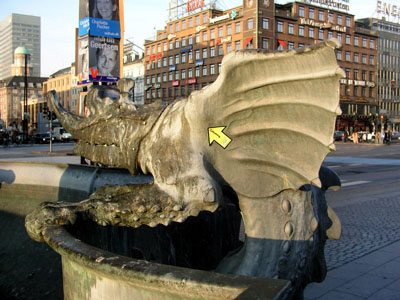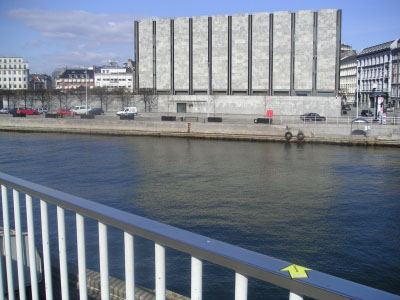 |
[June 9th 2005]

From the site: http://denmark.yellowarrow.net
Pointing to the Hidden Stories of the City
The project Yellow Arrow lets you discover hidden layers of your city and place your own stories in the urban landscape. The project uses text messaging (SMS) as a way to link personal messages to certain locations, which mean something special to someone. You point the attention to the spot by placing a yellow arrow sticker with a unique code, thus making it possible for others to receive the story. Thomas Petersen asked the Yellow Arrow organization a few questions about the project, now that the project is being launched in Denmark.
Get your arrows at the website http://denmark.yellowarrow.net. Also, sign up for an invitation to the launch party at a secret location, Saturday June 11th at 8 pm!
Read more about the Danish partner Urbanites.org: http://www.supertanker.info/19123. More links to Yellow Arrow events at the end of this document.
Tell me the basics about the Yellow Arrow project. What's the general idea and how does it work?
Yellow Arrow is a global public art project that subverts the hierarchy of media power by creating an open forum for communication. The project invites the questions 'When does an object become art? What makes a landmark? Who says what counts?' By collecting and sharing places of personal significance, this public collaboration creates an subjective atlas, what we as initiators have called 'a dynamic M.A.A.P.'; a Massively Authored Artistic Project, that expresses the unique characteristics, personal histories, and hidden secrets which live within our everyday spaces.
The basics for the project are stickers, text messaging and the urban environment. Participants place uniquely coded Yellow Arrow stickers to draw attention to different locations and objects. By sending a text-message (SMS) from a mobile phone to the Yellow Arrow number beginning with the arrow's unique code, Yellow Arrow authors essentially save a thought on the spot where they place their sticker. Messages range from short poetic fragments to personal stories to game-like prompts to action. When another person encounters the Yellow Arrow, he or she sends its code to the Yellow Arrow number and immediately receives the message of that arrow on their mobile phone. The website www.yellowarrow.net extends this location-based exchange, by allowing participants to annotate their arrows with photos and maps in the online gallery of Yellow Arrows placed throughout the world.

From the site: http://denmark.yellowarrow.net
How will the project be implemented in Denmark and how can the Danes get into it?
One strategy is to let it go out with the word of mouth, contacting different art and technology networks to start up projects using the Yellow Arrow - and connecting it to different kinds of media coverage. We are launching the project in Denmark with a series of very exciting events this week that incorporate many different communities and highlight a lot of the different aspects of the project. On June 9th there will be a talk at the IT University organized by Crossroads Copenhagen. And the launch is also a part of the 6th European Biennial, for which Urban Task Force is organizing the workshop Street Creativity. In this context, we will host a one-hour midnight harbor ride using audio recordings, text messaging and illuminating large Yellow Arrow sculptures and have a big party with video projections on Saturday night. The location of the party will be announced exclusively through a text mob that people sign up for.
The second strategy is to go for a broader public through the collaboration with the daily newspaper Politiken, where their website will be used for people to vote for the best arrows and making articles on the people and their thoughts behind the choice of place and text.

From the site: http://denmark.yellowarrow.net
There is currently a massive focus on the artistic use of locative media and mobile technology, which seem to have revitalized psychogeographical projects. What makes the mobile phone interesting as an art medium and what does this specific tradition of urban art mean to you?
With mobile technology, we are now able to integrate the social potential of networked experience with the immediacy of the physical world. As Baudrillard wrote in response to the student strikes of 1968:
'The real revolutionary media were the walls and their speech, the silk-screen posters and the hand painted notices, the street where speech began and was exchanged - everything that was an immediate inscription, given and turned, spoken and answered, mobile in the same space and time, reciprocal and antagonistic. The street is, in this sense, the alternative and subversive form of the mass media, since it isn't, like the latter, an objectified support for answerless messages, a transmission system at a distance. It is the frayed space of the symbolic exchange of speech - ephemeral, mortal.'
In a networked age, different communities across the globe have very different access to technology, but mobile phones have become widely available. By perceiving a network as something that is inherently a combination of physical, social, and technological components, this project brings these elements together under a paradigm that honors the type of vibrant exchange Baudrillard found so inspiring.
More Yellow Arrow events in Copenhagen:
Thursday, June 9th, 2-6 pm.
- Yellow Arrows will be presented at the IT University of Copenhagen. Click here for info.
Friday, June 10th, midnight.
- Go on a midnight harbour ride, 'an interactive, place-specific journey using text messaging and audio recordings to navigate through the visible and invisible landscape of Copenhagen Harbour' http://www.cityliving-livingcity.org/news.php
Saturday, June 11th, 1 pm.
- Yellow Arrows will be presented at Overgaden - Institut for Samtidskunst, Copenhagen, http://www.overgaden.org.
Saturday June 11th, 8 pm.
- Launch at secret location
|
 |
|